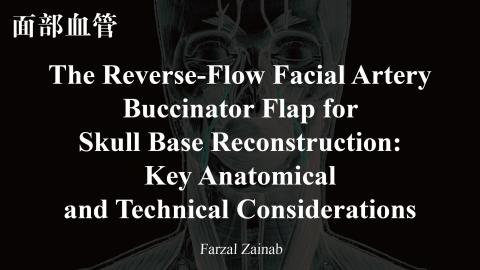
- 3772人
- 分享收藏
The Reverse-Flow Facial Artery Buccinator Flap for Skull
Farzal Zainab
简介
【 文献重点摘要 】
Objective
To highlight key anatomical and technical considerations for facial artery identification, and harvest and transposition of the facial artery buccinator (FAB) flap to facilitate its future use in anterior skull base reconstruction. Only a few studies have evaluated the reverse-flow FAB flap for skull base defects.
Design
Eight FAB flaps were raised in four cadaveric heads and divided into thirds; the facial artery’s course at the superior and inferior borders of the flap was measured noting in which incisional third of the flap it laid. The flap’s reach to the anterior cranial fossa, sella turcica, clival recess, and contralateral cribriform plate were studied. A clinical case and operative video are also presented.
Results
The facial artery had a near vertical course and stayed with the middle (⅝) or posterior third (⅜) of the flap in the inferior and superior incisions. Seven of eight flaps covered the sellar/planar regions. Only four of eight flaps covered the contralateral cribriform region. Lastly, none reached the middle third of the clivus.
Conclusions
The FAB flap requires an understanding of the facial artery’s course, generally seen in themiddle third of the flap, and is an appropriate alternative for sellar/ planar and ipsilateral cribriform defects.
Keywords
skull base reconstruction, facial artery buccinator flap, cerebrospinal fluid leak, facial artery
目的
强调面动脉识别、面动脉颊肌(FAB)瓣切取和移位的解剖学和技术要点,为其在前颅底重建中的应用奠定基础。只有少数研究评价了逆流FAB瓣在颅底缺损中的应用。
设计
在4具身体头上抬起8块FAB皮瓣,分成3/3,测量面动脉在皮瓣上、下缘的走行,记录皮瓣的哪个切口1/3。研究皮瓣到达前颅窝、鞍区、斜坡隐窝和对侧筛板的情况。文中还提供了一个临床病例和手术录像。
结果
面动脉近垂直走行,在上、下两个切口与皮瓣中(⅝)或后1/3(⅜)相吻合。8个皮瓣中有7个覆盖鞍区/平面区。8个皮瓣中只有4个覆盖对侧筛状区。最后,没有人到达斜坡的中间三分之一。
结论
FAB皮瓣需要了解面动脉的走行,通常见于皮瓣的中1/3,是鞍面和同侧筛状缺损的一种合适的选择。
关键词
颅底重建术,面动脉颊肌皮瓣,脑脊液漏,面动脉



